
Ponce is both a city and a municipality on the southern coast of Puerto Rico. The city is the seat of the municipal government.

Mercedita International Airport is a public use international airport located three nautical miles (6 km) east of the central business district of Ponce, Puerto Rico. The airport covers 270 cuerdas of land and has one runway. It was inaugurated as an international airport on 1 November 1990. It was built with combined funds from the Municipality of Ponce and the Commonwealth of Puerto Rico.

Melicoccus bijugatus is a fruit-bearing tree in the soapberry family Sapindaceae, native or naturalized across the New World tropics including South and Central America, and parts of the Caribbean. Its stone-bearing fruits are edible. It is also called Bajan ackee, genip, guinep, genipe, ginepa, kenèp, quenepa, quenepe, quenette, chenet, skinup, talpa jocote, mamón, limoncillo, canepa, skinip, kenepa, kinnip, huaya, or mamoncillo.
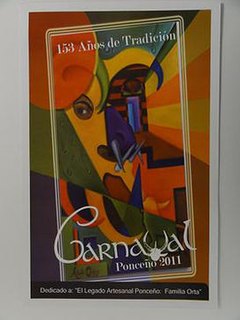
The Carnaval de Ponce, officially Carnaval Ponceño, is an annual celebration held in Ponce, Puerto Rico. The celebration lasts one week and it ends on the day before Ash Wednesday. Thus, it is generally held in February and sometimes in March. It is one of the oldest carnivals of the Western Hemisphere, dating back to 1858. Some authorities, such as the Smithsonian Institution, believe the Ponce Carnaval can be traced to as far back as 250 years ago. The Carnaval coincides with the Mardi Gras of New Orleans, the Carnival of Venice, and Rio de Janeiro's Carnival. The estimated attendance is 100,000. Scenes of the 2011 Carnaval Ponceño were featured in the Travel Channel on 7 August 2011.
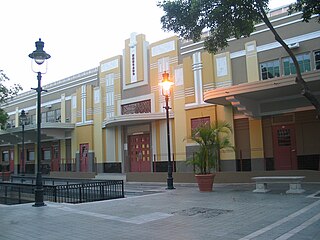
Plaza del Mercado de Ponce or, formally, Plaza del Mercado Isabel Segunda, is a historic marketplace building in Ponce, Puerto Rico. It was inaugurated in 1863 by Ponce Mayor Don Luis de Quixano. Designed by famed engineer Timoteo Luberza, it occupies a city block in the Ponce Historic Zone at the grid formed by Calle Atocha, Estrella, Leon, and Castillo streets. It has room for 65 kiosks. It was originally called Plaza del Capá.
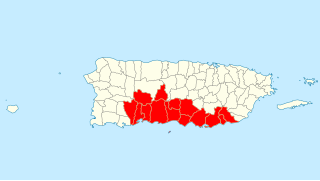
Porta Caribe is a tourism region in southern Puerto Rico. It was established in 2003 by the Puerto Rico Tourism Company, an agency of the Government of Puerto Rico. When created in 2003 it consisted of 14 municipalities in the south central zone. With the creation of the neighboring Porta Cordillera zone in July 2012, the municipalities of Adjuntas and Jayuya were transferred to the newly created Porta Cordillera zone and Porta Caribe became a 12-municipality tourism region. The name Porta Caribe translates to "Doorway to the Caribbean." Its executive director is Maritza W. Ruiz Cabán.

The Ponce Plaza Hotel & Casino, formerly Ponce Ramada Hotel and Ponce Plaza Ramada Hotel, is a five-story hotel in Ponce, Puerto Rico. The hotel opened in the summer of 2009 and is known for the historic value of its structure: its main entrance is a historic colonial structure known as "Casa Saurí". In February 2013, the hotel expanded its facilities to include a casino, a cocktail lounge, and a 4-story, 200-car parking garage. On 1 July 2014, the owners left the Ramada namesake franchise and renamed the hotel Ponce Plaza Hotel & Casino.
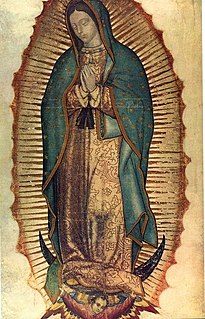
Fiestas patronales in Puerto Rico are yearly celebrations held in each municipality of the island. Like in other countries, "fiestas patronales" are heavily influenced by Spanish culture and religion, and are dedicated to a saint or virgin.

SITRAS, officially, Sistema Integrado de TRAnsportación del Sur, is the mass transit system in the city of Ponce, Puerto Rico. The service was inaugurated on 14 February 2012.

Día Mundial de Ponce is a cultural celebration held in Ponce, Puerto Rico, every year during the month of September. The celebration actually starts the Monday before Labor Day with various evening-time cultural festivities. It then culminates with the grand parade that takes place on the Sunday before Labor Day. The celebration started in 2012 and has an estimated attendance of 4,000 people. The week-long event aims to celebrate the cultural heritage of the city by giving tribute to the organizations, the people and "the great sons and daughters of the city of Ponce." The first year of this celebration, the Grand Parade took place on the last Sunday of the celebration, but starting in 2013, the week-long events ended on a Saturday and the Grand Parade was changed to take place the last Saturday. That year the celebration was also changed to occur the last weekend of September, rather than the weekend before Labor Day.

Archivo Histórico de Ponce is a historical archive in Ponce, Puerto Rico. It is considered "the most complete historical archive in Puerto Rico".

The Ponce Jazz Festival is a musical celebration that takes place every year in Ponce, Puerto Rico.

Cruce a Nado Internacional is a yearly international swimming competition that takes place at Bahía de Ponce in Ponce, Puerto Rico. It is the oldest open water swimming event in the Caribbean. The event generally occurs on the first Sunday of September, to coincide with the Sunday of Labor Day Weekend every year. The event is sponsored by Club Cruce a Nado, Inc. Some 100 athletes compete, swimming 1.5 nautical miles nautical miles. The event started in 1980. The 2020 season's event did not take place due to the COVID-19 pandemic, but its 40th season took place on 5 September 2021 instead.

The Fiesta Nacional de la Danza, also known as Semana de la Danza Puertorriqueña, is a cultural celebration that takes place every year in Ponce, Puerto Rico. The festival centers on the danza, a musical genre native from the city of Ponce and oftentimes called "Puerto Rico's classical music" with rhythm, tune, and cadence that are similar to the waltz. The celebration lasts a week and takes place in mid-May. It is sponsored by the Ponce Municipal Government and the Institute of Puerto Rican Culture.
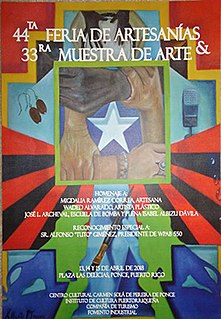
The Feria de Artesanías de Ponce, formally, Feria de Artesanías y Muestra de Arte de Ponce, is an event that takes place every year in Ponce, Puerto Rico, where artists, craftsmen and artisans showcase their products. The products showcased are traditionally hand-made and in small quantities. The fair centers around crafts that highlight the traditional cultural background of Puerto Rico, including Taino, African, and Spanish traditions. The event started in 1974 and is reported to draw "thousands of visitors". It lasts three days and is held over a weekend during the month of April.

Bienal de Arte de Ponce is a biennial international art exhibition that takes place in Ponce, Puerto Rico, during the month of November. The event is sponsored by the Commission on the Arts of the University of Puerto Rico at Ponce. It has been called "the most important art biennial in Puerto Rico." As a biennial event, it takes place once every two years.
Las Mañanitas is an annual event held in Ponce, Puerto Rico, dedicated to Our Lady of Guadalupe. It consists of a pre-dawn popular parade, followed by a Catholic Mass, and a popular town breakfast hosted by the municipal government. It takes place on December 12, and is a traditional event sponsored by the Roman Catholic Diocese of Ponce but attended by Catholic leaders from Puerto Rico at large. Widely covered by the press every year, the event is attended by over 10,000 people, including religious and political leaders and the general public. Due to the coronavirus pandemic, the 2020 celebration will take place in a modified program fashion: there will be no walked procession, as traditionally done, but instead the Eucharist will be televised and would-be attendees can instead celebrate Las Mañanitas from their own homes.

The Carnaval de Vejigantes, officially Carnaval de Vejigantes de La Playa de Ponce, is an annual celebration held at Barrio Playa in Ponce, Puerto Rico. The celebration, which commonly lasts three to five days, generally takes place in late January or early February. It started in 1991. It takes place at Parque Lucy Grillasca on PR-585 in Barrio Playa. The parade, one of the highlights of the carnival, usually takes off from Cancha Salvador Dijols on Avenida Hostos (PR-123) and ends at Parque Lucy Grillasca (PR-585). Attendance is estimated at over 15,000 people. It is attended by people from all over Puerto Rico, and some attendees are from as far as the United States. It is organized and operated by a community, civic, NGO group, not by any government or government agency.



















